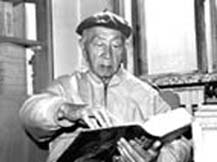 "Huang Scattering", "Huang Equations", "Huang-Phys factor", these are familiar terms in the world of physics, and the word "Huang" in each term stands for one person.
"Huang Scattering", "Huang Equations", "Huang-Phys factor", these are familiar terms in the world of physics, and the word "Huang" in each term stands for one person.
That person is Huang Kun, an academician at the Chinese Academy of Sciences (CAS) and a well-known Chinese physicist. Huang, 82, is an internationally known physicist who has made many important pioneering contributions to solid state physics.
As important as he is, Huang is still very modest. He even claims he has "only a limited amount of knowledge".
"Some people are born to be marshals, some are born to be soldiers. I belong to the latter group, just a small soldier. To be a solider means you will have to fight at the front."
On February 1, Friday President Jiang Zemin awarded the "small soldier" the highest honor possible, the State Preeminent Science and Technology Award 2001. Besides the honor, Huang also receives five million yuan (US$ 600 thousand).
Addressing the award ceremony, Huang said his award belongs to every scientist in the country. Huang said he has done "just a little", and he really hates being in the spotlight. However, the truth is, what he has accomplished is by no means "just a little".
Zhang Ligang, an American academician, said under Huang's guidance, what the Chinese scientists have achieved in crystal lattice research is no by no means less than their most outstanding counterparts the world over.
He theoretically predicted, in the late 1940s, diffuse X-ray scattering associated with the impurities in crystal lattices, which was experimentally confirmed in the 1960s, and later named "Huang Scattering", and has already developed into an effective and direct method for studying micro-defects in solids.
His multiphonon transition theory through its "Huang-Rhys factor" has become widely known in the field. He proposed a pair of equations relating to optional displacement, macroscopic electric fields and electric polarization (Huang Equations) which led him to discover for the first time coupled vibratory modes between optical vibration and the electromagnetic field which has come to be called "polariton".
He is widely known among physicists for his collaboration with Max Born in writing the monograph "Dynamic Theory of Crystal Lattices". This theoretical work is of practical and important significance and has a guiding role for the information industry (especially the opto-electronics industry ).
For the last half century, he has been not only making important contributions to solid state physics, but at the same time making great contributions to the teaching of general physics, solid state physics and semiconductor physics in colleges and universities.
In recent years, he has achieved remarkable success with his colleagues, in collaborative research, in the electronic states and phonon modes in semiconductor super lattices.
Huang was born in September 1919 in Beijing and graduated from the department of physics at Yenching University in 1941. He went to England in 1945 to study at the University of Bristol. In 1948 he obtained his doctorate and from 1949-1951 did post-doctoral research at the University of Liverpool. From 1951-1977 he was a professor in the department of physics at Peking University. From 1977-1983 he was director of the Institute of Semiconductors, at the Chinese Academy of Sciences. Since 1983 he has been the honorary director of the Institute.
From 1977 to 1983, Huang's research group was honored with nearly 40 awards for their achievements. This success can be attributed to hard work and effort.
"I was almost 60 years old in 1977, and that is not an ideal age for one to do research. What's worse, I had been away from that kind of work for a long time. But I was persistent and did everything that I needed to do. After more than ten years, I finally achieved something," He recalled.
Nearly half a century ago, at the age of 36, Huang became a member of the CAS, the youngest academician of the time. He was elected a foreign member of the Royal Swedish Academy of Sciences in 1980, and a member of the Third World Academy of Sciences in 1985.
Summing up his life work, Huang said he experienced two peaks of creativity, one when doing post-doctorate research work in Britain and the other when working at the Semiconductor Institute.
"Scientists should be receptive to both problems and opportunities. Remember, creativity is of the uttermost importance," said the 82-year-old award winner.
(China.org.cn February 7, 2002)
